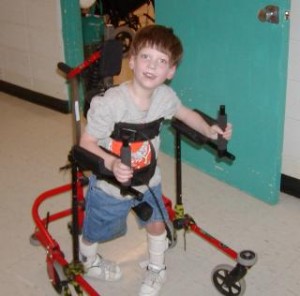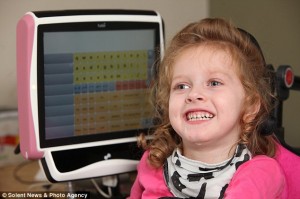Hearing, Speech & Vision Problems for Kids with Cerebral Palsy
Children who suffer from CP oftentimes need specialized treatment and medical devices to assist them with problems involving hearing and speech. Cerebral palsy causes damage to the parts of the brain that control these faculties, and in many cases, these difficulties lead to problems learning and keeping up in school.

Cerebral Palsy & Communication
Hearing & Speech Impairments
Children with cerebral palsy often have problems speaking clearly, which at times can make it difficult to understand what they’re trying to say. Some children with severe CP may even be unable to speak.
This stems from the fact that cerebral palsy affects control over the muscles, and that speech requires a very complex interaction of the tongue, teeth, face, lips and other muscles. With good coaching and speech therapy, people with cerebral palsy can become quite adept at speech, but they still may have a distinctive sound to the way they speak. Here are some ways that you can learn to understand better.
1. Listen Closely
Learning to understand somebody with cerebral palsy can be a bit like learning to understand somebody who has a heavy accent. You simply have to learn how they pronounce words that you are accustomed to hearing pronounced a bit differently than the way they do it. If a person with cerebral palsy gets good access to speech coaching, they’re speaking patterns will generally be more-consistent. This means that it gets easier and easier to understand them as you talk to each other.
2. Slow Down
Some people with cerebral palsy also have trouble hearing. If you’re having a hard time communicating to your child, make certain of these things:
- They can see your face.
- You’re speaking clearly and concisely.
- You’re in adequate light.
We all ask people to repeat themselves on the phone more than we do in real life. Seeing someone’s mouth move is a big part of understanding their speech. For people with hearing impairments, it’s even more important (even if they don’t read lips). Remember not to over-enunciate your words—it merely confuses things; speak naturally, but clearly.
3. Try Different Words
Sometimes, it will be impossible to get somebody with a severe hearing impairment to understand everything you say. If this is the case, try using different words. Sometimes, it’s just a matter of background noise or some other complication making it too difficult for somebody to understand you clearly. Using a shorter, simpler word will sometimes clear up the issue right away.
Vision Problems in Children With Cerebral Palsy
Children born with cerebral palsy face different challenges. One such challenge is visual impairment. Cerebral palsy typically affects the muscles of the whole body, sometimes including the muscles controlling the eyes.
Decades of European research states that up to one third of individuals born with cerebral palsy may have some form of moderate visual distortion. At the same time, 10 percent of all children with CP have serious visual impairment. This may limit their ability to see clearly, read, interact with the environment and others as well as avoid potential hazards around them.
Cortical Visual Impairment

Cerebral Palsy & Eyesight Problems
The most common type of visual impairment associated with cerebral palsy is called “cortical visual impairment.” This usually happens due to damage within parts of the brain responsible for processing visual stimuli. In this kind of scenario, the child may have numerous difficulties such as recognizing familiar places, faces and other things. They may also have a hard time seeing different things at the same time, as well as knowing where things are in a three dimensional setting.
Further problems associated with cortical visual impairment include:
- Making quick eye movements.
- Getting tired of using their eyes quickly.
- Focusing when they are looking at an object that’s close by.
- Blurred or missing fields of vision.
Thankfully, the vision problems connected to cortical visual impairment in children can get better with time. Currently, there are no restorative treatments to cure impaired vision brought on by brain damage. However, a few things such as wearing glasses or contact lenses may really help.
Strabismus
Strabismus is another common form of vision loss. This usually involves both eyes, and it’s manifested with the eyes looking in different directions. For example, one eye may turn sideways while the other looks inwards. After a while, the brain starts to ignore signals coming from one eye, leading to a common eye disorder known as amblyopia or “lazy eye.”
Because of the loss of muscle tone, children with cerebral palsy may also have a problem with shortsightedness or long sightedness. These can be corrected using laser eye surgery, although it’s not recommended for younger kids.
